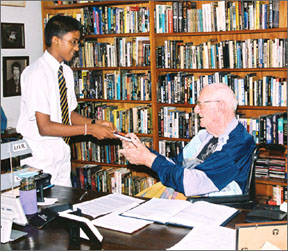 Our maiden war panegyric? Our maiden war panegyric?
Title: Kustantheenu Hatana
Edited Rohini Paranawithana
Published by Godage and Bros.
by Padma Edirisinghe
Wars that kill precious human lives by 1000s are nothing to boast
about but we have to acknowledge the fact that ever since human
civilization began aggression and not peace is the norm of human
behaviour that is characteristic of even the highest circles.
One only feels sorry for the founders of religions who always
advocated Shanthi (peaceful bliss) along with messages like "Love thy
neighbour". On the contrary 'The neighbour "turns out to be the
bitterest foe.
 Recently the reviewer read an interesting piece on the Mandalay
theory that expounds the practice of hating the neighbouring state and
loving the nation beyond that. Just to ensure the balance of power, that
is and not for any Shanthi purpose. Recently the reviewer read an interesting piece on the Mandalay
theory that expounds the practice of hating the neighbouring state and
loving the nation beyond that. Just to ensure the balance of power, that
is and not for any Shanthi purpose.
Aggressive humans just began loving wars as time passed by and
indulged in them profusely using various causes, significant or
insignificant. The 'fabled jackal' waiting to pick a fight needs mention
here.
He was hunting, not for food, but for something to be nasty about,
with another of his tribe. Unable to find anything worthwhile he jumped
on a passing jackal - brother, pointed at a stone and said. "This stone
is mine."
The passing fox, a beautiful one not in a mood for a squabble very "shanthily"
said, "If it is yours, take it, dear brother". Despite the dirty
reputation they have earned down the ages foxen are beautiful animals
and I even read a story the other day about a woman who had fallen in
love with one.
But that is another tribe not the human tribe who have so far
indulged in 1000s and 1000s of wars mainly for self-glorification and
self-aggrandizement. We, the Lankans, being occupants of an island in
the centre of a vast ocean along which ships plied East and West from
ancient days have had umpteen foreign visitors. They came, they saw but
did not stoop to conquer except for some cruel invaders like Magha. But
the Europeans were all for land grabbing and illegal trespass.
The firearms were the biggest asset of the invaders which began to be
imitatively manufactured by islands like Lanka very soon. Rajasinghe I
or Tikiri Kumaru Rajasinghe was our first king to use these against the
Western trespassers.
Naturally via Sitawaka Hatana, he earned our first War panegyric or
Prashasthi eulogizing him and his valour displayed on the battlefield.
In fact this book of verses can be called our maiden war panegyric.
Next comes Kusthantheenu Hatana. Believe it or not, this is a
panegyric or Prashasthi that eulogises the foreign invader who becomes a
victor against the local king.
Treacherous? Down to the very core. But humans are humans, and
greediness is one of their main assets other than the propensity for
quarrelling. Greed for status, for a higher post, for State recognition
no doubt propelled the author to undertake this work, now edited by one
of our well-known scholars, Prof. Rohini Paranavithana.
Constantine da Saa, the Portuguese General who ruled the littoral in
the years, 1618-1620 and again in the years 1623-1630 is the hero of
this work who won his battle against King Senarat of Kandy and his sons.
According to the editor though wars have been described in detail in
our ancient and medieval texts war literature as a separate component
sprouted during the Portuguese era. The famous poet Alagiyawanna is
surmised to be its author who it is assumed was subject to conversion.
Hence the book is very innovative in that while using techniques of
eulogy rampant in earlier books as Sitawaka Hatana and Parakumba Siritha
the author begins his panegyric by paying homage to Jesus Christ (just
as was done to Buddha) and then in the act of describing the war goes on
often to eulogise the war hero, Constantine Da Saa inundating him with
praise for killing and defeating his own country men. (Da Saa however
gets killed later at Radeniwela by Rajasinghe II).
Anyway the main message in this book review that such a book (which
some present day anti-conversion fanatics would have consumed to fire
straight away if they got hold of it) had been preserved down the ages
in our own temples.
For despite the treachery of the poet the book is of outstanding
poetic excellence having been penned by a brilliant poet named
Alagiyawanna Mukaweti who produced works like Kusa Jathaka Kavya, Daham
Soda Kavya, Subhashithaya and Savul Sandeshaya.
In fact in an era when Sinhala literature had plummeted to its lowest
depths it was he and his father, Pundit Dharmadvaja both denizening the
village of Hissella in Siyane Korale who had kept the torch of learning
afloat.
It is not too far fetched to surmise that they embraced the new
religion for their own survival and progress in the literary renaissance
they had launched if not for which the flow of Sinhala language and
literature may have seen a total eclipse. (Descendants of this family
still living in Gampaha and surrounding areas now seem to have reverted
back to Buddhism).
From the introduction to the book written by the editor it is clear
that the author had exerted herself much to go through earlier editions.
Scholar, Louis de Soyza had been instrumental in finding it from a
library belonging to Ellawala Rate Mahathmaya.
In 1894 Mudaliyar F. W. de Silva had enlightened academics and
"non-academics" of the Royal Asiatic Society on the existence of this
work Kusthanteenu Hatana which not only gives a very extensive account
of the waged war but throws light on the routes taken by the armies
during this time - Malwana, Mapitigama, Kananpella, Kaluaggala, Kosgama,
Bope, Sitawaka, Teppanawa in Uva province, Kohompitiya, Pollamure,
Balangoda, Maddegama, Imbulpe, Lellopitiya where the Sinhala army is
defeated in a fierce battle Da Saa, Phillip Da Livera and Louis Tissera
end up heroes.
But the most interesting fact about this book that can be reckoned as
the optimum evidence of the amazing Buddhist tolerance is that an
edition of this work published by the Catholic Press in Colombo and
edited by Fr. S. G. Perera has been recommended as a school text. No,
not by a colonial govt.stooging to the religion of Christ but by three
Buddhist scholars, all Buddhists, Munidasa Cumaranatunga, Edwin Ranawaka
and P. Wijesekera. Only pages 116 to 112 have been excluded, not because
of vituperations poured against Buddhists but due to undue obsession
with large breasts of women! How far ahead Sri Lankan scholars seem to
stand before Western counterparts in this respect!
They were not involved with racial and religious prejudices but only
with the high literary aspect of the work.
Journey to Netronic
First Edition - May 2007
|

Author - Yashod Savithru Jayasinghe
|
|

Cover page of the book
|
This is a science fiction book written by a 15 year old boy, Yashod
Savithru Jayasinghe who is a Grade II student of Royal College, Colombo.
The story is an adventure of a group of school boys, which links our
world, a parallel world of a different time, and the world of virtual
reality. The author is trying to peep in to the future using technology
in day to day life by referring to a parallel time.
Being a school boy himself, the book suggests many novel options
using technology to relieve burdens faced by students and people of our
age.
His scientific predictions extend to a variety of fields from
transport, communication, education, to the currencies of tomorrow. It’s
worthwhile taking this journey to Netronic...a parallel world.....
|

Author presents the first copy of the book to Sir Arthur C. Clarke |
|
